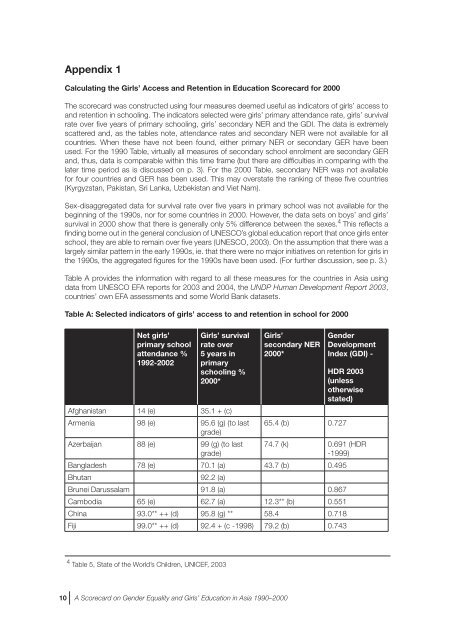A Scorecard on gender equality and girls ... - unesdoc - Unesco
A Scorecard on gender equality and girls ... - unesdoc - Unesco
A Scorecard on gender equality and girls ... - unesdoc - Unesco
You also want an ePaper? Increase the reach of your titles
YUMPU automatically turns print PDFs into web optimized ePapers that Google loves.
Appendix 1<br />
Calculating the Girls’ Access <strong>and</strong> Retenti<strong>on</strong> in Educati<strong>on</strong> <str<strong>on</strong>g>Scorecard</str<strong>on</strong>g> for 2000<br />
The scorecard was c<strong>on</strong>structed using four measures deemed useful as indicators of <strong>girls</strong>’ access to<br />
<strong>and</strong> retenti<strong>on</strong> in schooling. The indicators selected were <strong>girls</strong>’ primary attendance rate, <strong>girls</strong>’ survival<br />
rate over five years of primary schooling, <strong>girls</strong>’ sec<strong>on</strong>dary NER <strong>and</strong> the GDI. The data is extremely<br />
scattered <strong>and</strong>, as the tables note, attendance rates <strong>and</strong> sec<strong>on</strong>dary NER were not available for all<br />
countries. When these have not been found, either primary NER or sec<strong>on</strong>dary GER have been<br />
used. For the 1990 Table, virtually all measures of sec<strong>on</strong>dary school enrolment are sec<strong>on</strong>dary GER<br />
<strong>and</strong>, thus, data is comparable within this time frame (but there are difficulties in comparing with the<br />
later time period as is discussed <strong>on</strong> p. 3). For the 2000 Table, sec<strong>on</strong>dary NER was not available<br />
for four countries <strong>and</strong> GER has been used. This may overstate the ranking of these five countries<br />
(Kyrgyzstan, Pakistan, Sri Lanka, Uzbekistan <strong>and</strong> Viet Nam).<br />
Sex-disaggregated data for survival rate over five years in primary school was not available for the<br />
beginning of the 1990s, nor for some countries in 2000. However, the data sets <strong>on</strong> boys’ <strong>and</strong> <strong>girls</strong>’<br />
survival in 2000 show that there is generally <strong>on</strong>ly 5% difference between the sexes. 4 This reflects a<br />
finding borne out in the general c<strong>on</strong>clusi<strong>on</strong> of UNESCO’s global educati<strong>on</strong> report that <strong>on</strong>ce <strong>girls</strong> enter<br />
school, they are able to remain over five years (UNESCO, 2003). On the assumpti<strong>on</strong> that there was a<br />
largely similar pattern in the early 1990s, ie. that there were no major initiatives <strong>on</strong> retenti<strong>on</strong> for <strong>girls</strong> in<br />
the 1990s, the aggregated figures for the 1990s have been used. (For further discussi<strong>on</strong>, see p. 3.)<br />
Table A provides the informati<strong>on</strong> with regard to all these measures for the countries in Asia using<br />
data from UNESCO EFA reports for 2003 <strong>and</strong> 2004, the UNDP Human Development Report 2003,<br />
countries’ own EFA assessments <strong>and</strong> some World Bank datasets.<br />
Table A: Selected indicators of <strong>girls</strong>’ access to <strong>and</strong> retenti<strong>on</strong> in school for 2000<br />
Net <strong>girls</strong>’<br />
primary school<br />
attendance %<br />
1992-2002<br />
Girls’ survival<br />
rate over<br />
5 years in<br />
primary<br />
schooling %<br />
2000*<br />
Afghanistan 14 (e) 35.1 + (c)<br />
Armenia 98 (e) 95.6 (g) (to last<br />
grade)<br />
Azerbaijan 88 (e) 99 (g) (to last<br />
grade)<br />
Girls’<br />
sec<strong>on</strong>dary NER<br />
2000*<br />
Gender<br />
Development<br />
Index (GDI) -<br />
HDR 2003<br />
(unless<br />
otherwise<br />
stated)<br />
65.4 (b) 0.727<br />
74.7 (k) 0.691 (HDR<br />
-1999)<br />
Bangladesh 78 (e) 70.1 (a) 43.7 (b) 0.495<br />
Bhutan<br />
92.2 (a)<br />
Brunei Darussalam 91.8 (a) 0.867<br />
Cambodia 65 (e) 62.7 (a) 12.3** (b) 0.551<br />
China 93.0** ++ (d) 95.8 (g) ** 58.4 0.718<br />
Fiji 99.0** ++ (d) 92.4 + (c -1998) 79.2 (b) 0.743<br />
4 Table 5, State of the World’s Children, UNICEF, 2003<br />
10<br />
A <str<strong>on</strong>g>Scorecard</str<strong>on</strong>g> <strong>on</strong> Gender Equality <strong>and</strong> Girls’ Educati<strong>on</strong> in Asia 1990–2000

















